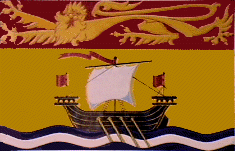|
|
|
New Brunswick |
 |
|
The LandNew Brunswick borders on Nova Scotia, Quebec and the U.S. state of Maine. It is rectangular in shape, extending 322 kilometres north to south and 242 kilometres east to west. New Brunswick has a land mass of 73 500 km2, 85 percent of which is forest. The northern part of the province is quite mountainous, the tallest peak being Mount Carleton at 820 metres high. The interior consists mainly of a rolling plateau, flatter in the east and more hilly in the southeast. The main rivers are the Miramichi, Nepisguit, Restigouche and Saint John. Known as "oa-lus-tuk" or "beautiful river" to the Aboriginal people, the Saint John waters the fertile lands of the western part of the province over a distance of 725 kilometres. Downstream, in the Madawaska area, it traces a natural boundary between Canada and the state of Maine. Twice a day, with the rising tide of the Atlantic Ocean, 100 billion tonnes of water stream past a rocky headland in the Bay of Fundy. The current created is practically equal to the flow of all the world's rivers over a 24-hour period. The eastern end of the Bay has tides of nearly 15 metres, the highest in the world, sufficient to completely submerge a four-storey building. The HistoryThe existence of New Brunswick was known to the Europeans as early as the 1400s, when intrepid Basque fishermen plied their trade off Miscou in the northeast region of the province. At that time, the region was inhabited by the Malecite and Micmac peoples. The Micmacs were the first to receive Samuel de Champlain and the French when they landed in New Brunswick in 1604. The Aboriginal people established good relations with the French from the outset, helping the French settlers, known as Acadians, to adapt to their new country and taking part in the French attacks on New England. The British and French feuded over the area for a century. Control passed back and forth until 1713, when Acadia was ceded to the British under the Treaty of Utrecht. With time, France lost interest in the Acadians, turning most of its attention to New France and the burgeoning fur trade. By 1755, England had established its dominance as a colonial power. Fearing that the Acadians were a security threat, the British deported, mainly to the United States, more than 10 000 Acadians who would not swear allegiance to the British Crown. Their exile lasted eight years, after which a significant number returned to their homeland. The New Brunswick we know today was first part of Nova Scotia. In 1783, the western part of Nova Scotia became the home of thousands of Loyalists who had taken flight in the aftermath of the American Revolution. These American colonists, wishing to remain faithful to the British Crown, founded communities in the northern part of present-day New Brunswick and soon were anxious to establish a new colony. The separation of territory took effect in 1784 and the name "New Brunswick" was chosen in honour of King George III (1760-1820), a descendant of the Brunswick House. In 1867, New Brunswick joined other provinces to form the Dominion of Canada. The PeopleIn 2000, the population of New Brunswick was 757 000. With the highest percentage of Francophones outside Quebec (almost 35 percent), New Brunswick is Canada's only officially bilingual province. The heritage of New Brunswick's people is a blended one, combining elements of the French, British Loyalist, Scottish and Irish traditions, with later elements of German, Scandinavian and Asian. The little municipality of New Denmark boasts North America's largest Danish colony. The Aboriginal people of New Brunswick number more than 10 000, most of them Micmac and Malecite. The coasts and river valleys are the areas of heaviest population; Saint John is the largest city, followed by Moncton and Fredericton, the provincial capital. The EconomyLeading the manufacturing industries is food, followed by wood-based industries, pulp and paper and related products, metal processing and transportation equipment. Processing of non-metallic ores and primary metals is also a significant manufacturing industry. Tourism is a vital part of the province's economy. In 1998, nearly 1.5 million people visited New Brunswick's tourist attractions, including its two national parks and numerous provincial parks. New Brunswick has an abundance of natural resources. Forests occupy 85 percent of the land mass; consequently, wood and wood products are a cornerstone of the economy, with black spruce and fir leading the list. Mining, too, is important. New Brunswickers mine silver, bismuth, cadmium, coal, copper, natural gas, gold, oil, lead, potash, peat, tungsten, silica, salt and zinc. Fishing and agriculture are also very important. More than 50 varieties of fish and shellfish are caught here; in fact, the town of Shediac has been called the"lobster capital of the world."In agriculture, New Brunswick is self-sufficient in the production of forage, milk and poultry. Its potatoes are renowned in over 25 countries; strawberries, apples, blueberries and vegetables are produced for local consumption and for export. New Brunswick exports a great deal to the New England states - more than $2.5 billion in 1999. Petroleum products, lumber, electrical energy, frozen lobsters and wood pulp are among the most exported commodities. In recent years, New Brunswick has undertaken an effort to further promote economic development that has resulted in new industries and companies being established in the province. Information technology has been a growth industry for the province, which now describes itself as the "Call Centre Capital of North America," with more than fifty companies having established facilities in the province. |
|
| Back | |
| Source: Communication Canada | |
| Related Sites: Government of New Brunswick New
Brunswick Library - Canada Online Directory |
|
|
|
|
| Top Home |